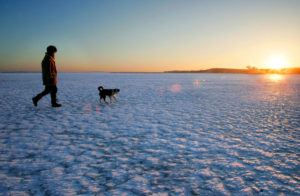
On certain mornings, in all seasons, the lowest temperature is often recorded just after sunrise. (Photo credit: State Journal Archives)
Those who keep a particularly vigilant eye on the weather might have noticed that on certain mornings, in all seasons, the lowest temperature is often recorded just after sunrise.
One of us had a morning paper route as a boy and was puzzled for years about this seemingly counterintuitive phenomena. How could the temperature continue to fall for the few minutes after sunrise on a cold winter morning?
The answer lies in the fact that the Earth and the sun radiate different kinds of energy and one needs to consider the budget of this energy to make sense of this recurring observation.
On a clear, calm winter night the Earth’s surface radiates infra-red energy upward towards space. With the sun already down, there is no shortwave solar radiation (and only a very little infra-red energy from the overlying atmosphere) directed downward toward the surface. Consequently, with each passing second, the surface emits more energy than it receives and the surface temperature drops.
This continues all through the night with the accumulated loss of infra-red energy from the surface accounting for the continued decrease in the surface temperature. When the sun finally rises above the horizon and spreads the first faint rays of solar energy across the surface, there is finally some incoming radiation. However, for several minutes the meager amount of incoming radiation is not sufficiently large to counter the amount of infra-red energy still being emitted from the surface. As a result, the surface temperature continues to drop even in the face of the newly risen sun. Science wins again.

